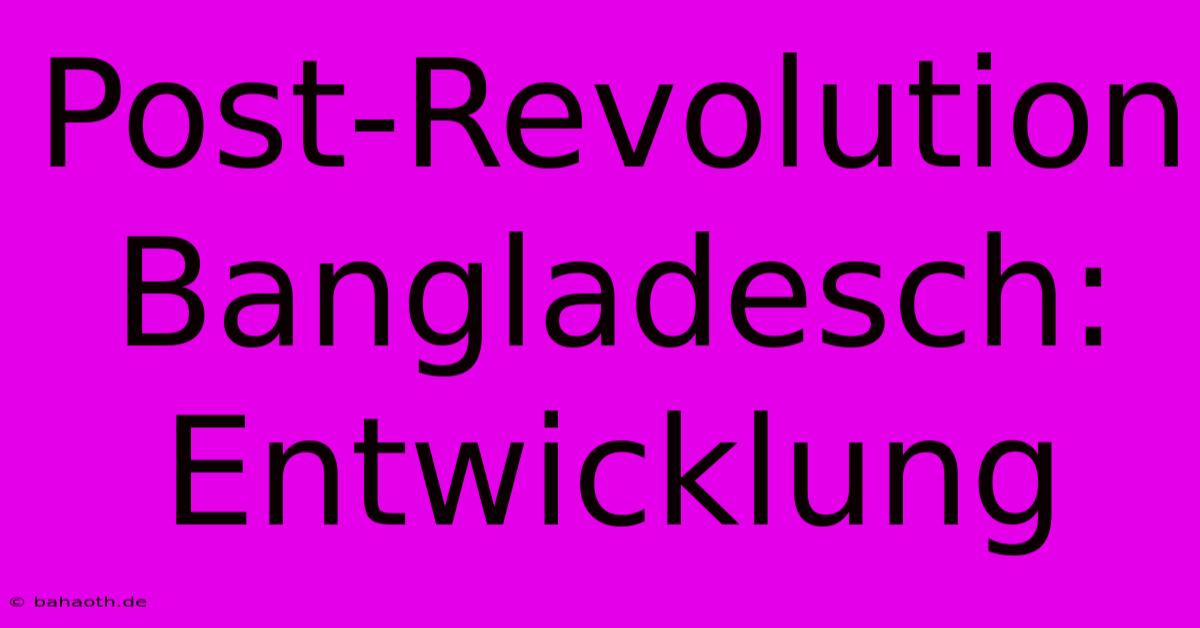Post-Revolution Bangladesch: Entwicklung

Discover more detailed and exciting information on our website. Click the link below to start your adventure: Visit Best Website Post-Revolution Bangladesch: Entwicklung. Don't miss out!
Table of Contents
Post-Revolution Bangladesch: Entwicklung – A Look Back and Ahead
Hey everyone, so I wanted to talk about something that’s been on my mind lately: the development of Bangladesh post-revolution. It's a complex topic, right? And honestly, I've made some major mistakes trying to understand it fully. Like, I once thought focusing solely on micro-loans was the only way to boost the economy…boy, was I wrong! It's way more nuanced than that.
The Early Years: A Rollercoaster Ride
The period immediately following the 1971 liberation was, to put it mildly, chaotic. Imagine trying to rebuild a country from scratch after a brutal war – talk about a huge challenge. There were serious infrastructural issues, widespread poverty, and political instability. It was a real mess, a total clusterfudge at times. You know, like trying to build a sandcastle during a hurricane.
We often overlook the sheer scale of the humanitarian crisis. Millions were displaced, infrastructure was destroyed, and the economy was in tatters. The initial years were marked by significant challenges in food security, healthcare, and education. Getting things running smoothly after a war like that? Yeah, not easy. It took a lot of international aid, but the foundation for future progress was laid. Slowly, painstakingly, brick by brick.
Economic Growth and its Challenges
Over the decades, Bangladesh has shown remarkable economic growth. Seriously, the progress has been impressive, going from one of the poorest nations to a developing economy. The ready-made garment (RMG) industry has been a major driver of this growth, creating millions of jobs. But it's not without its issues.
The dependence on the RMG sector is a double-edged sword. While it provides employment for millions, it's also vulnerable to global economic shocks. Think about the impact of the COVID-19 pandemic – it really highlighted the fragility of this reliance. Diversifying the economy is crucial for long-term sustainability. I've learned this the hard way! We need to look at other sectors like agriculture, technology, and tourism to create a more resilient and balanced economy.
Key Factors in Development:
- Microfinance Initiatives: While my initial understanding was overly simplistic, microfinance has played a significant, albeit limited role. It's helped empower many women entrepreneurs, which is great.
- Remittances: Money sent home by Bangladeshis working abroad has been a crucial source of income and investment. This influx of foreign currency has massively boosted the economy.
- Infrastructure Development: Significant investment in infrastructure, from roads and bridges to power generation, has been essential for economic growth.
- Improved Healthcare and Education: Increased access to healthcare and education have played a vital role in improving the overall human capital of the country.
The Road Ahead: Sustainable Development Goals
Looking ahead, Bangladesh faces significant challenges. Climate change poses an existential threat, with rising sea levels and extreme weather events impacting agriculture and livelihoods. Addressing these issues requires a multi-pronged approach focusing on adaptation and mitigation strategies. It's a massive undertaking, requiring international cooperation and innovative solutions. We need to think long-term. Real long-term.
Another big challenge is ensuring inclusive and equitable growth. Progress needs to benefit all segments of society, not just a privileged few. Reducing inequality and promoting social justice are essential for sustainable development.
Learning SEO isn't easy either! Getting your articles to rank high involves a lot of trial and error. But, the rewards make it all worthwhile. It's not just about keywords; it's about creating valuable content people will actually read and share. And that's what I'm aiming for here. Hopefully, this post helps you understand Bangladesh's post-revolution development. Let me know your thoughts in the comments below!

Thank you for visiting our website wich cover about Post-Revolution Bangladesch: Entwicklung. We hope the information provided has been useful to you. Feel free to contact us if you have any questions or need further assistance. See you next time and dont miss to bookmark.
Featured Posts
-
Arbeitssieg Koelner Einzelkritik Muenster
Nov 23, 2024
-
Mega Strafe Billigflieger Muessen Zahlen
Nov 23, 2024
-
Kane Hattrick Bayerns Sieg Perfekt
Nov 23, 2024
-
Tauber Odenwald Outdoor Im Winter Geniessen
Nov 23, 2024
-
Anthropic Erhaelt 4 Milliarden Von Amazon
Nov 23, 2024
